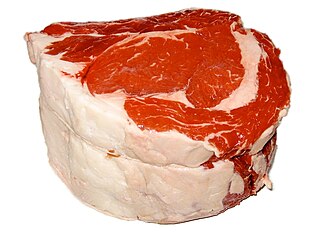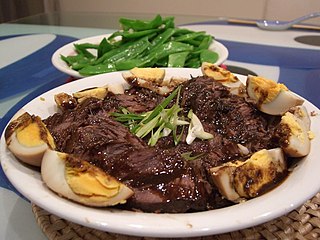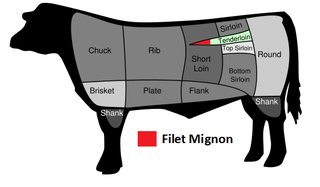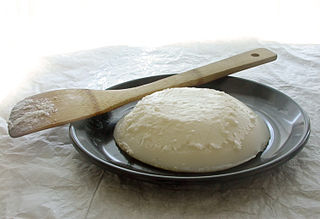
Meat hanging is the culinary process of dry-aging meat to develop its flavor and tenderness.

Meat hanging is the culinary process of dry-aging meat to develop its flavor and tenderness.
Traditionally, game meat was hung until "high" or "gamey", that is, approaching a state of decomposition. [1]
For dry-aged beef, the meat is hung in a room kept between 33–37 degrees Fahrenheit (1–3 degrees Celsius), with relative humidity of around 85%. If the room is too hot, the meat will spoil, and if it is too cold, the meat freezes and dry aging stops. Good ventilation prevents bacteria from developing on the meat. The meat is checked on regularly. [2]
Meat hanging allows processes to continue in the meat that would normally cease in dead animals. For example, the muscles in the meat continue to use the hemoglobin that is stored in the soft tissue of the animal. This normal biological process creates lactic acid. Contrary to popular belief, animals cannot be completely drained of bodily fluid during slaughter, since soft tissue necessarily retains some amount of fluid. This can be well observed by cooking a steak and observing "blood" on the plate. Since the blood is no longer being circulated through the body, the lactic acid starts to break down the muscle and connective tissues around it. [3]
The process takes at a minimum eleven days. The longer the meat is hung, the better the flavor will be, but also the higher the chance that the meat will spoil. Most companies limit hanging to 20–30 days. [2] Up to 10–15% of the water content may evaporate. [3]
As the meat ages, its color goes from red to purple, and the texture becomes firmer. [3]
In the 1960s, the cheaper wet-aging process largely displaced dry aging as dry-aged meat is 15–25% more expensive than wet-aged beef: dry hanging rooms are expensive; meat weight is reduced through evaporation; and some proportion of meat spoils. [4] [3]
Dry aging became more popular in the 1980s, and dry aged beef continues to be sold in high-end restaurants around the world. [4]

Ham is pork from a leg cut that has been preserved by wet or dry curing, with or without smoking. As a processed meat, the term "ham" includes both whole cuts of meat and ones that have been mechanically formed.

Beef is the culinary name for meat from cattle.

Marinating is the process of soaking foods in a seasoned, often acidic, liquid before cooking. The origin of the word alludes to the use of brine in the pickling process, which led to the technique of adding flavor by immersion in liquid. The liquid in question, the marinade, can be either acidic or enzymatic, or have a neutral pH. In addition to these ingredients, a marinade often contains oils, herbs, and spices to further flavor the food items.
In food processing, brining is treating food with brine or coarse salt which preserves and seasons the food while enhancing tenderness and flavor with additions such as herbs, spices, sugar, caramel and/or vinegar. Meat and fish are typically brined for less than twenty-four hours while vegetables, cheeses and fruit are brined in a much longer process known as pickling. Brining is similar to marination, except that a marinade usually includes a significant amount of acid, such as vinegar or citrus juice. Brining is also similar to curing, which usually involves significantly drying the food, and is done over a much longer time period.

Braising is a combination-cooking method that uses both wet and dry heats: typically, the food is first browned at a high temperature, then simmered in a covered pot in cooking liquid. It is similar to stewing, but braising is done with less liquid and usually used for larger cuts of meat. Braising of meat is often referred to as pot roasting, though some authors make a distinction between the two methods, based on whether additional liquid is added. Osso buco and coq au vin are well known braised meat dishes, and the technique can be used to prepare fish, tempeh, tofu or fruits and vegetables.

A beefsteak, often called just steak, is a flat cut of beef with parallel faces, usually cut perpendicular to the muscle fibers. In common restaurant service a single serving has a raw mass ranging from 120 to 600 grams. Beef steaks are usually grilled, pan-fried, or broiled. The more tender cuts from the loin and rib are cooked quickly, using dry heat, and served whole. Less tender cuts from the chuck or round are cooked with moist heat or are mechanically tenderized.

Salami is a cured sausage consisting of fermented and air-dried meat, typically pork. Historically, salami was popular among Southern, Eastern, and Central European peasants because it can be stored at room temperature for up to 40 days once cut, supplementing a potentially meager or inconsistent supply of fresh meat. Countries and regions across Europe make their own traditional varieties of salami.
Ground beef, minced beef or beef mince is beef that has been finely chopped with a knife or a meat grinder or mincing machine. It is used in many recipes including hamburgers, bolognese sauce, meatloaf, meatballs and kofta.

Beef aging or ageing is a process of preparing beef for consumption by aging it, in order to break down the connective tissue within the meat.
Rendering is a process that converts waste animal tissue into stable, usable materials. Rendering can refer to any processing of animal products into more useful materials, or, more narrowly, to the rendering of whole animal fatty tissue into purified fats like lard or tallow. Rendering can be carried out on an industrial, farm, or kitchen scale. It can also be applied to non-animal products that are rendered down to pulp.

Filet mignon is a cut of meat taken from the smaller end of the tenderloin, or psoas major of an animal carcass. In French, it mostly refers to cuts of pork tenderloin.

Skirt steak is a cut of beef steak from the plate. It is long, flat, and prized for its flavor rather than tenderness. It is not to be confused with hanger steak, a generally similar adjacent cut also from the plate.

Charcuterie is a French term for a branch of cooking devoted to prepared meat products, such as bacon, ham, sausage, terrines, galantines, ballotines, pâtés, and confit, primarily from pork.

Doneness is a gauge of how thoroughly cooked a cut of meat is based on its color, juiciness, and internal temperature. The gradations are most often used in reference to beef but are also applicable to other types of meat.

Basting is a cooking technique that involves cooking meat with either its own juices or some type of preparation such as a sauce or marinade. The meat is left to cook, then periodically coated with the juice.
Pale, Soft, Exudative meat, or PSE meat, describes a carcass quality condition known to occur in pork, beef, and poultry. It is characterized by an abnormal color, consistency, and water holding capacity, making the meat dry and unattractive to consumers. The condition is believed to be caused by abnormal muscle metabolism following slaughter, due to an altered rate of glycolysis and a low pH within the muscle fibers. A mutation point in the ryanodine receptor gene (RYR1) in pork, associated to stress levels prior to slaughter are known to increase the incidence of PSE meat. Although the term "soft" may look positive, it refers to raw meat. When cooked, there is higher cook loss and the final product is hard, not juicy.

Lard is a semi-solid white fat product obtained by rendering the fatty tissue of a pig. It is distinguished from tallow, a similar product derived from fat of cattle or sheep.

A steak, also sometimes called "beef steak", is a meat generally sliced across the muscle fibers, potentially including a bone. It is normally grilled, though it can also be pan-fried. Steak can also be cooked in sauce, such as in steak and kidney pie, or minced and formed into patties, such as hamburgers.

Fermented sausage, or dry sausage, is a type of sausage that is created by salting chopped or ground meat to remove moisture, while allowing beneficial bacteria to break down sugars into flavorful molecules. Bacteria, including Lactobacillus species and Leuconostoc species, break down these sugars to produce lactic acid, which not only affects the flavor of the sausage, but also lowers the pH from 6.0 to 4.5–5.0, preventing the growth of bacteria that could spoil the sausage. These effects are magnified during the drying process, as the salt and acidity are concentrated as moisture is extracted.
Tenderness is a quality of meat gauging how easily it is chewed or cut. Tenderness is a desirable quality, as tender meat is softer, easier to chew, and generally more palatable than harder meat. Consequently, tender cuts of meat typically command higher prices. The tenderness depends on a number of factors including the meat grain, the amount of connective tissue, and the amount of fat. Tenderness can be increased by a number of processing techniques, generally referred to as tenderizing or tenderization.